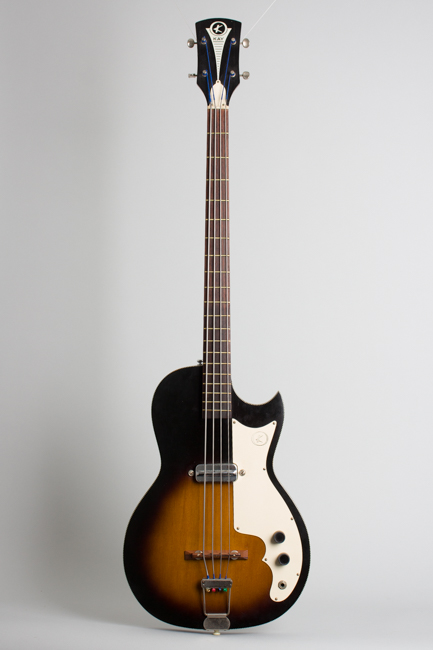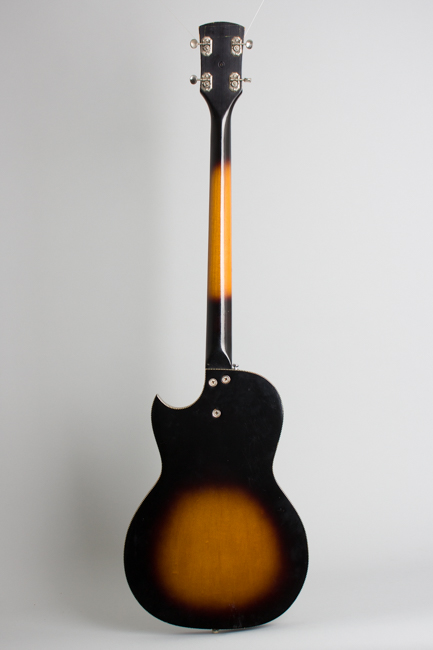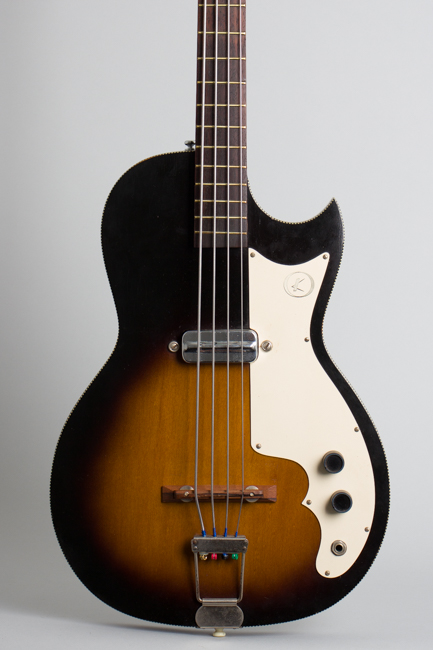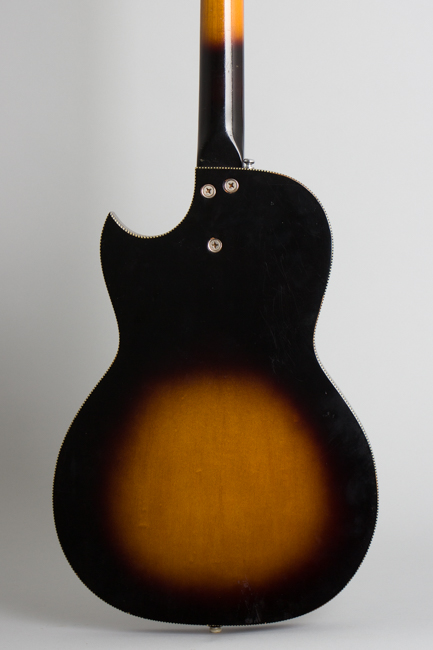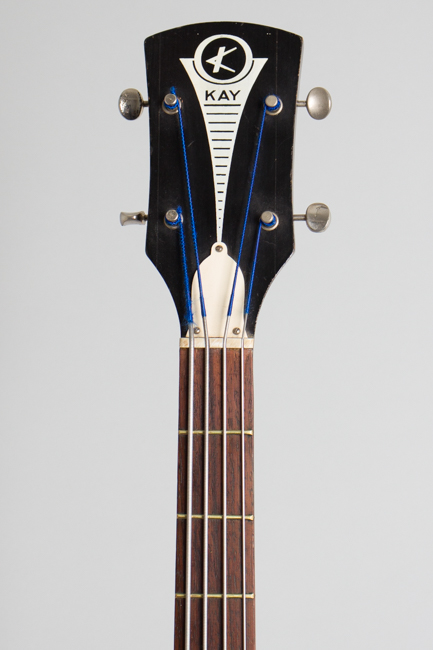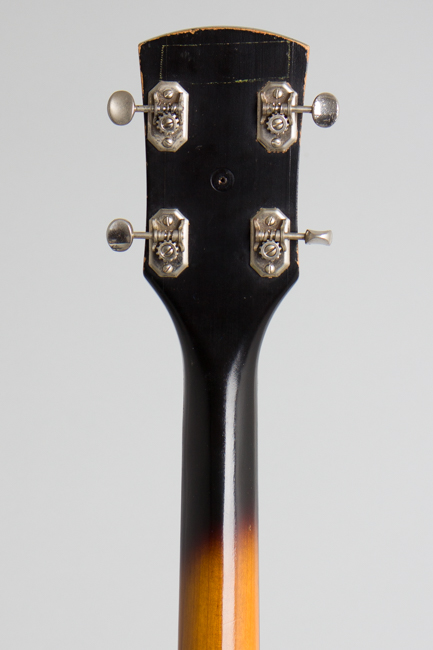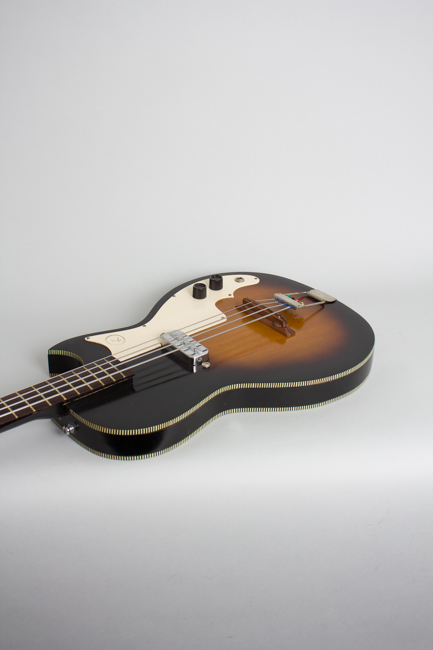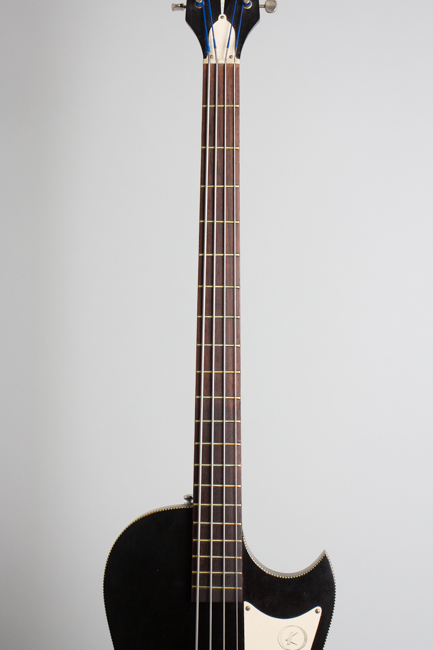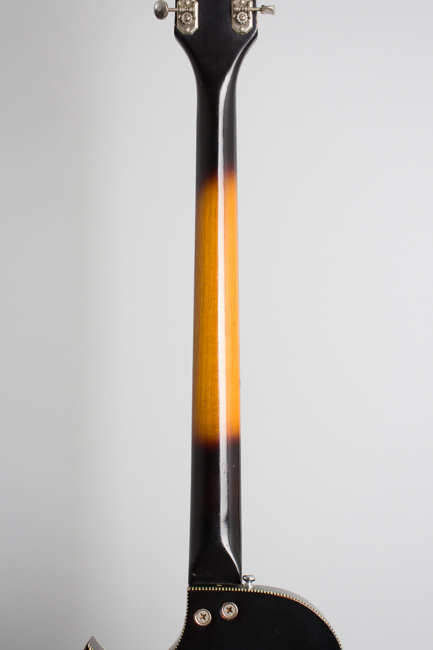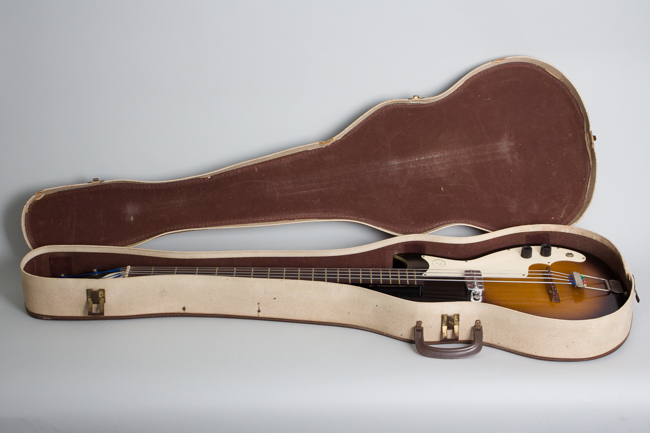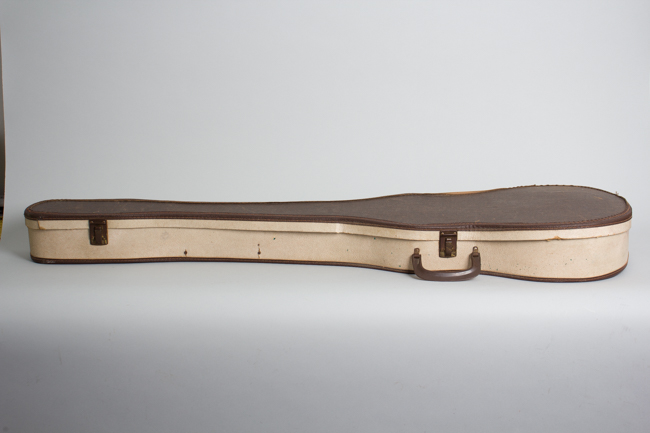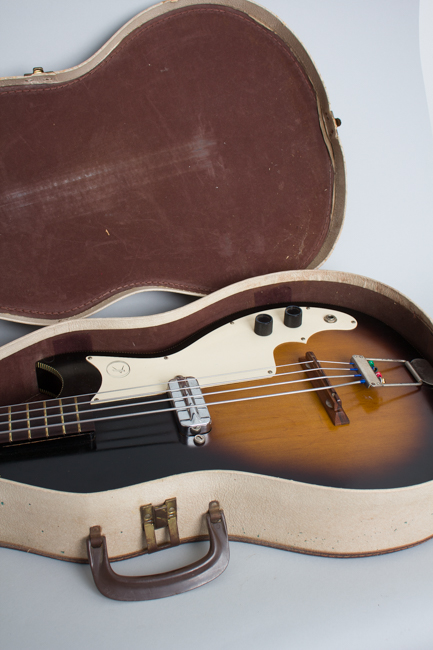Kay K-5915 Semi-Hollow Body Electric Bass Guitar (1965)
This item has been sold.
Item # 11516
Prices subject to change without notice.
Kay K-5915 Model Semi-Hollow Body Electric Bass Guitar (1965), made in Chicago, sunburst finish, laminater maple body, poplar neck with rosewood fingerboard, original brown chipboard case.
Kay is generally considered the second commercially successful electric bass guitar maker, following quickly on the heels of Fender in 1952. Kay were the king of commercial grade upright basses at the time, and likely saw the Fender Precision Bass as a looming threat. Kay offered a completely different design using a shorter, thinner neck on a hollow cutaway guitar body. This was perhaps a quick design decision but made for a completely different feeling and playing instrument from the Fender. In many ways it was nearly as influential, the Kay Electric bass being the direct ancestor of all acoustic/electric hollow body bass guitars, also introducing the common 30" short scale that many of them share.
This instrument is the original Kay Electric Bass' budget mid-'60s descendant, designated Model K-5915. It has a fairly conservative look with a single-cutaway 13 1/4" flat-topped box of a body finished in a dark shaded sunburst, with black-white "zipper" side binding on the top and back. The single "speed bump" pickup is mounted in the center of the body, over a white plastic pickguard with tone and volume controls. The neck is very thin across but fairly deep back-to front, a Kay trademark. The small headstock is adorned with the "K" Kay stenciled logo and four Kluson openback guitar tuners that look surplus from the late 1940s.
While definitely a student model the K-5915 still boasts more solid construction than many imports of the time, but little stylistic flair. By the mid-1960s the hollow body bass concept was hugely popular, but Kay's designs rather undistinguished. This bass is a fairly late example of Kay's student-oriented offerings dating to 1965, when it listed for $82.50 plus $14.50 case for the chipboard case. The pots are dated to the 37th week of 1965.
This was Kay's slightly cheaper equivalent to the very popular Harmony H-22, simply made but decent sounding and playable instrument. While it has not been re-discovered the way the H-22 has, the K-5920 is still a respectable budget entry in the 1960s hollow body bass sweepstakes with a surprisingly good sound.
Overall length is 43 1/2 in. (110.5 cm.), 13 1/4 in. (33.7 cm.) wide at lower bout, and 1 3/4 in. (4.4 cm.) in depth, measured at side of rim. Scale length is 30 in. (762 mm.). Width of nut is 1 7/16 in. (36 mm.).
This bass remains in far better condition than many of these, and after some tweaks to the neck and frets a far better player than most. The finish has some minor wear, and there is a later strap button added to the heel and small extra strap button holes drilled in the heel and (!) back of the headstock. All else remains original; the small decorative inserts have fallen out of the knobs.
The neck has been carefully straightened and this is actually quite a playable bass, albeit with very narrow string spacing for many bass players. The sound has a nice acoustic character and it is not difficult to do a fairly convincing upright impression on this one, a tribute to Kay's roots! It is housed in the somewhat worn but still serviceable original chipboard case. Overall Excellent - Condition.
Kay is generally considered the second commercially successful electric bass guitar maker, following quickly on the heels of Fender in 1952. Kay were the king of commercial grade upright basses at the time, and likely saw the Fender Precision Bass as a looming threat. Kay offered a completely different design using a shorter, thinner neck on a hollow cutaway guitar body. This was perhaps a quick design decision but made for a completely different feeling and playing instrument from the Fender. In many ways it was nearly as influential, the Kay Electric bass being the direct ancestor of all acoustic/electric hollow body bass guitars, also introducing the common 30" short scale that many of them share.
This instrument is the original Kay Electric Bass' budget mid-'60s descendant, designated Model K-5915. It has a fairly conservative look with a single-cutaway 13 1/4" flat-topped box of a body finished in a dark shaded sunburst, with black-white "zipper" side binding on the top and back. The single "speed bump" pickup is mounted in the center of the body, over a white plastic pickguard with tone and volume controls. The neck is very thin across but fairly deep back-to front, a Kay trademark. The small headstock is adorned with the "K" Kay stenciled logo and four Kluson openback guitar tuners that look surplus from the late 1940s.
While definitely a student model the K-5915 still boasts more solid construction than many imports of the time, but little stylistic flair. By the mid-1960s the hollow body bass concept was hugely popular, but Kay's designs rather undistinguished. This bass is a fairly late example of Kay's student-oriented offerings dating to 1965, when it listed for $82.50 plus $14.50 case for the chipboard case. The pots are dated to the 37th week of 1965.
This was Kay's slightly cheaper equivalent to the very popular Harmony H-22, simply made but decent sounding and playable instrument. While it has not been re-discovered the way the H-22 has, the K-5920 is still a respectable budget entry in the 1960s hollow body bass sweepstakes with a surprisingly good sound.
Overall length is 43 1/2 in. (110.5 cm.), 13 1/4 in. (33.7 cm.) wide at lower bout, and 1 3/4 in. (4.4 cm.) in depth, measured at side of rim. Scale length is 30 in. (762 mm.). Width of nut is 1 7/16 in. (36 mm.).
This bass remains in far better condition than many of these, and after some tweaks to the neck and frets a far better player than most. The finish has some minor wear, and there is a later strap button added to the heel and small extra strap button holes drilled in the heel and (!) back of the headstock. All else remains original; the small decorative inserts have fallen out of the knobs.
The neck has been carefully straightened and this is actually quite a playable bass, albeit with very narrow string spacing for many bass players. The sound has a nice acoustic character and it is not difficult to do a fairly convincing upright impression on this one, a tribute to Kay's roots! It is housed in the somewhat worn but still serviceable original chipboard case. Overall Excellent - Condition.
